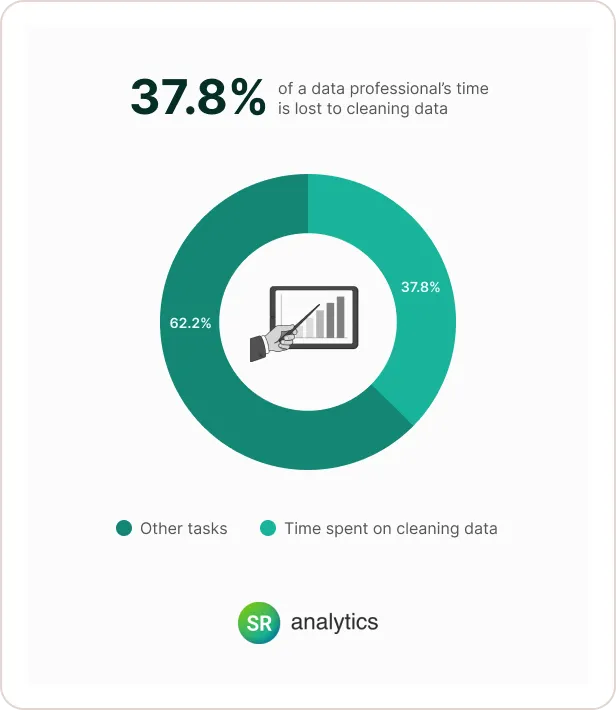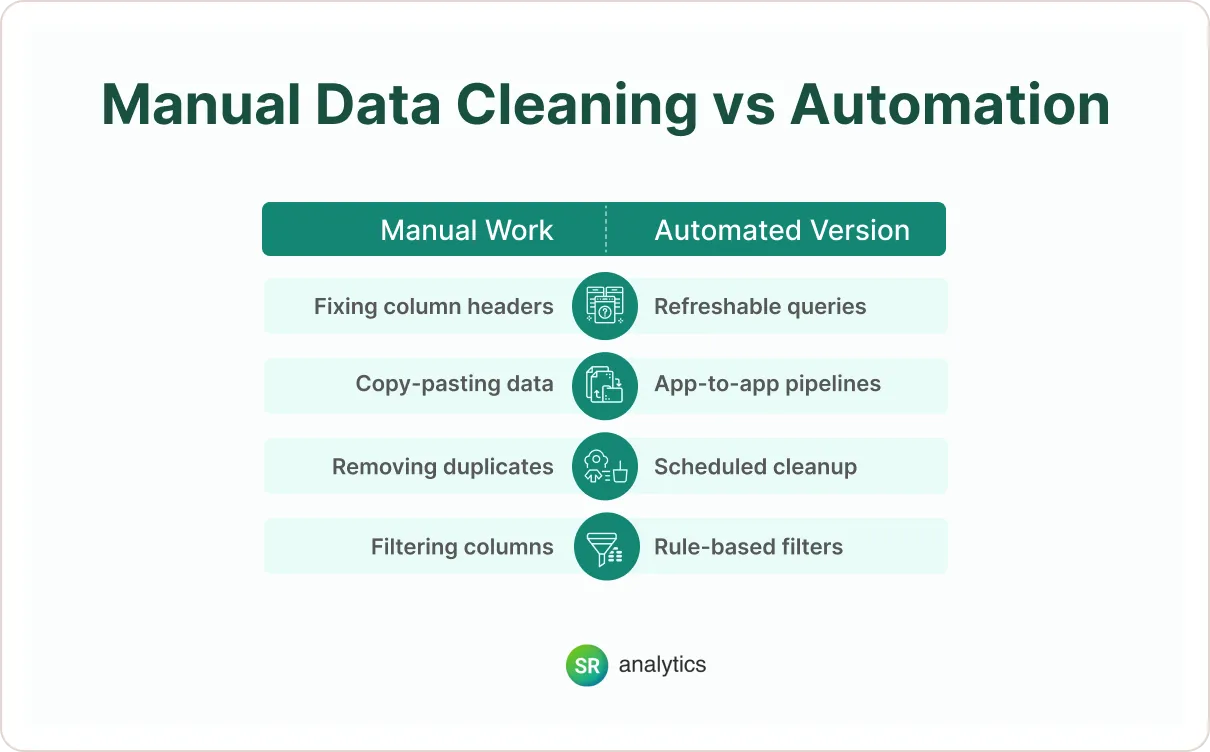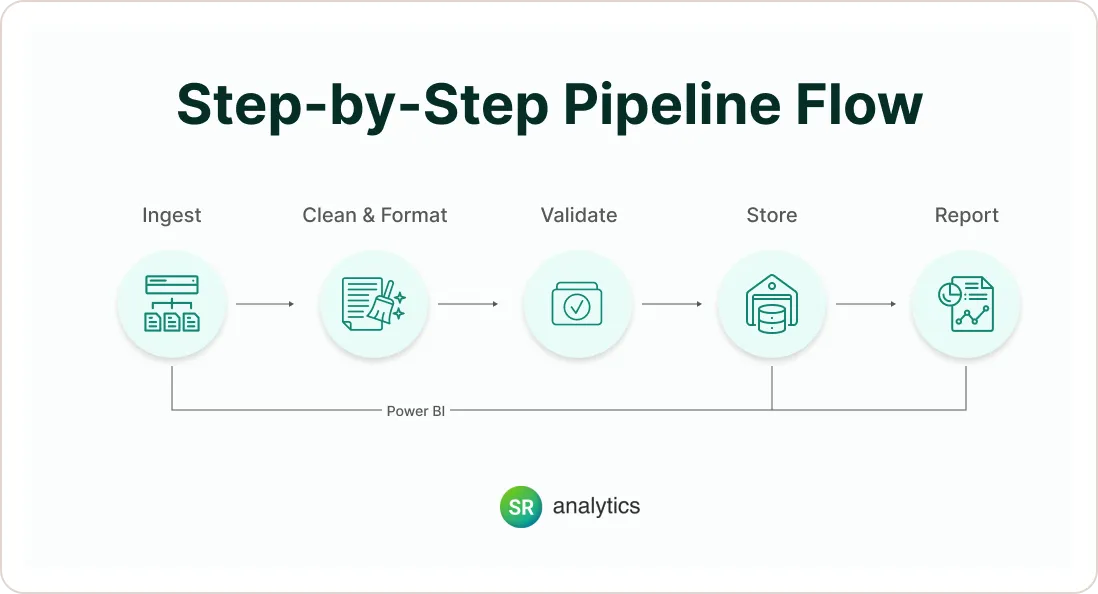Highlights
- Data professionals spend up to 37.8% of their time on cleaning tasks.
- Tools like Power BI, Zapier, and Excel + Power Automate offer zero-code automation.
- Automation reduces manual errors, improves consistency, and speeds up reporting.
- You don’t need a dev team—non-coders can build simple pipelines.
- One client saved 40+ hours/month by automating just one weekly report.
- Automation is the first step to building a fully streamlined data pipeline.
Introduction
Are you spending 20 hours/week cleaning disorganized data?
You’re not alone— around 37.8% of a data professional’s time is spent on data cleaning. Cleaning and preparing data manually is not just tedious, but also error-prone, and expensive.

But, the good news?
If you know how to automate data cleaning hacks, you can save time, money, and effort and utilize them to derive insights that matter.
In this article, we’ll tell you how simple data-cleaning automation steps can save those precious 20+ hours. These automation hacks are saving our clients serious time and money.
If manual data cleaning is silently poisoning your team’s productivity, you must understand where that time goes.
Manual Data Cleaning Is a Hidden Productivity Killer
Behind every refined and useful report goes hours of manual work. Without understanding the data & getting it ready for analysis, teams will not be able to proceed.
They will get stuck in a cycle of repetitive tasks without adding any strategic value.
Repetitive formatting
When done manually, tasks like fixing column headers and standardizing data formats, particularly dates and numbers, can be boring. They also tend to pile up too quickly.
Copy-pasting between reports
One dataset is often used in various reports.
Have you ever realized how much time you waste copy-pasting them across spreadsheets and tools?
Moreover, it also becomes difficult to standardize reports.
Manual deduplication and filtering
Not all the columns from a dataset are used in every report.
There are multiple times when you might have to filter out data manually.
Tasks like manual filters & deduplication can easily be part of data cleaning automation.
High risk of human error
To err is human – even the most cautious professionals tend to make silly mistakes, especially under tight deadlines.
A simple thing like a misplaced filter or an incorrect column name or by mistake deleting an existing column can throw off an entire report.
The result?
You end up spending more time finding data gaps & preparing them than analyzing them.
But right now, you do not need a big budget to automate data cleaning. First, try out these simple automation tricks. At a negligible cost or with zero coding knowledge, these can save hours every week.

3 Automation Hacks to Clean Data Without Coding
If you want to automate data cleaning and save your team’s precious time, here are three scalable solutions—no probs even if you aren’t a techie:
Hack 1: Power BI Power Query for Scheduled Cleaning
Even if you haven’t used Power BI, you can make the most of Power Query directly within Excel.
You can add the Excel data to the Power query using From Table/Range and clean data.
- Clean on refresh: You will not have to repeat the same steps. Tasks like removing duplicates, transforming columns, and applying filters, once done will be implemented every time you refresh the data.
- It’s also perfect for teams that want to get done with manual cleanup without leaving their BI environment.
Hack 2: Zapier + Google Sheets for Simple Pipelines
If you are looking for a zero-code data cleaning automation option, then use Zapier.
It’s a powerful automation tool with which you can connect your everyday apps—with no code.
- Trigger-based cleanup: If your data flows from emails, or other CRM portals, with Zapier, you can automatically extract it.
Then apply basic cleaning rules like removing blanks, or splitting columns, and push it into Google Sheets. - Zero code required: Once you set the cleaning steps using the drag-and-drop interface, it runs in the background.
Your team will save a lot of time from repetitive and manual formatting tasks.
Hack 3: Data Cleaning with Microsoft Excel + Power Automate
If your team is already using Microsoft 365, it’s time to make the most of Power Automate. Its no-code way helps streamline monotonous Excel-based cleaning jobs.
- Automate Excel workflows: When your team uploads a new file, it will trigger the predefined steps like applying filters, removing duplicates, and uploading the cleaned file to SharePoint or OneDrive folders.
- No coding is required for consistent output: It’s also based on drag-and-drop features, using which you can create flows. And once configured, no steps will be missed in future.
Pro Tip:
You can further use Google’s Cloud Scheduler to initiate data cleanup tasks on a set schedule which can be anything from minute to daily.
Once you’ve started with the automation tasks, you’ll need to streamline the system.
Let’s take a look at data pipeline automation.
What a Fully Automated Data Pipeline Looks Like

Data pipeline automation refers to the flow of data from raw input to final reports—without any manual intervention. It usually follows the following steps:
- Ingest: Data flows in from sources like CSV files, CRM systems or Google forms.
- Clean & Format: The cleaning & structuring of data is done using tools like Power Query (no-code) or Python (low-code).
- Validate: The pre-setup validation rules help in finding out outliers and errors before moving to the next step.
- Store: Now, the clean data is stored either in SharePoint or other scalable systems like SQL or any of your preferred Data Lake.
- Report: Finally, this data is used to prepare reports using tools like Power BI or Tableau. You can connect to the cleaned data and have access to real-time insights.
Each of the above steps can be scheduled. Thus, you & your team will not end up spending time fixing data but can focus on analyzing it.
Tools We Use to Automate Cleaning (and You Can Too)
By now, you already know the importance of automating data cleaning.
Here’s a list of tools with their pros and cons:
| Tool | Pros | Cons |
|---|---|---|
| Power BI Dataflows |
|
|
| Apache Airflow |
|
|
| Google Cloud Functions |
|
|
| Alteryx |
|
|
With the increase in data size, it becomes difficult to make the optimum utilization of these tools without technical knowledge. Data Analytics Services experts at SR Analytics help companies to streamline their workflow using these tools.
Client Story – How a SaaS Company Saved 40 Hours/Month
Client
A mid-sized SaaS team with four professionals.
Problem
They were spending hours preparing their weekly reports manually.
Solution
We did the ETL in Dataflows and automated the report with Power BI. Once that was done, we scheduled a weekly report refresh.
Result
As a result, they started saving around 10 hours/week. Moreover, their data was more accurate and their reports were never delayed.














